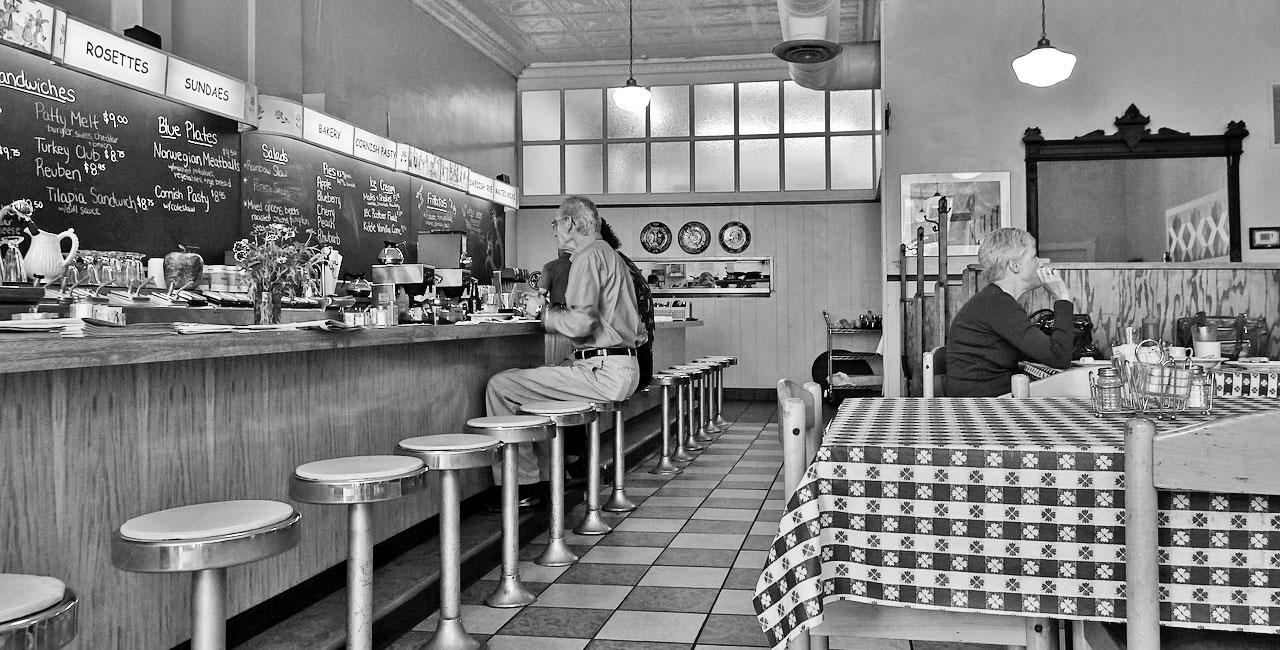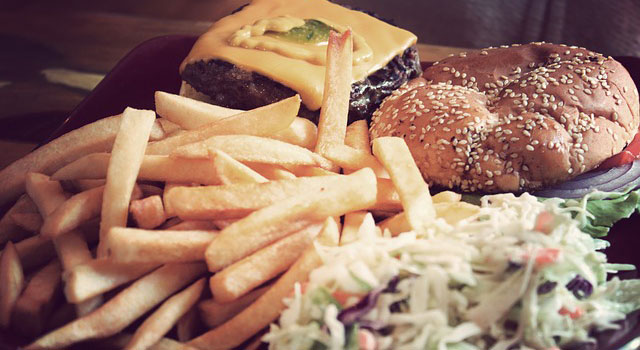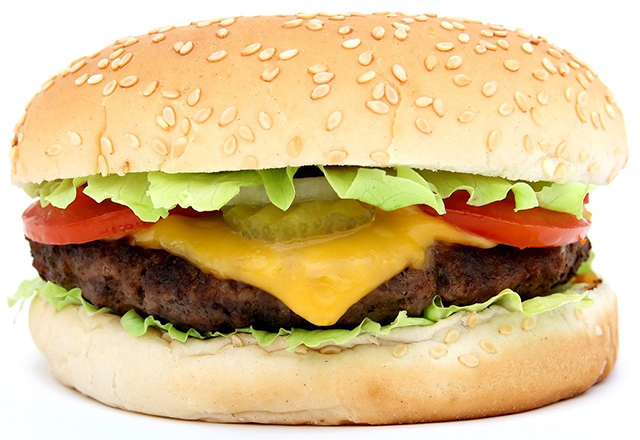How to Cook the Perfect Diner Burger

It’s both a science and an art …
Ah, the diner hamburger — an American gustatory icon. As a fry cook in the early 1980s I grilled thousands of them, every one made to order. Never got tired of them either.
If you’ve tried whipping up diner-style burgers at home, but you never seem to quite nail it, don’t despair. Your kitchen isn’t a diner galley, but trust me, you can do this …
Prep
If you’re used to cooking thick cuts like steaks, you’re accustomed to pulling the meat off the grill before it’s done and letting it “set up” a few minutes on the platter. You won’t be doing that here.
There should be about ten minutes between chilled patties touching a hot grill and your guests biting into them. That’s because we’re using thin patties. Let them sit around, it won’t be long til they’re cold and hard as your boss’s heart.
Which means everything’s gotta be ready to go before meat touches metal.

For the actual hamburger patty, start with 73% lean ground beef, or 80% lean at most. You need the fat for flavor and, as we’ll see, proper grilling. Work the beef as little as possible as you salt it, just enough to distribute the salt and meld the grinder “strings” so it holds together, and no more. Form 1/2″ (1.25 cm) thick patties — no thicker! — about 4″ (10 cm) across. You can use a jar lid lined with a sheet of Saran wrap to make them uniform if you like. Stack the patties with wax paper between the layers and chill in the fridge.
Do not add fillers, Worcestershire sauce, eggs, spices, or anything else. And in the name of all that is holy, do not knead the meat like dough.
To prep the buns, spread a little softened butter on the split sides and lightly toast them. It doesn’t really matter how, and they don’t have to be warm when the patties go on. Don’t overdo it — you just want a little toastiness on the inside surface.
Keep your toppings simple: Iceberg or green leaf lettuce, sliced tomatoes (lightly salted), sliced or diced onions, pickle chips. If you use iceberg lettuce you can slice or shred it if you like, but for green leaf just pull it apart. Yellow, red, or sweet onions will all work, depending on your taste. I prefer Vidalias, myself. Thinly sliced dills are your pickle go-to, but sweet dill chips can add a dash of the unexpected without crashing the classic diner flavor.
For sauces, stick to the classics — ketchup, mustard, mayo, thousand island dressing. Thousand island should be used by itself, as it combines creaminess, sweetness, and tang. Ketchup and mustard can each be used solo, in combo with mayonnaise, or together with each other. All three is overkill.
Personally, I leave mayo off cheeseburgers because you’ve already got enough fat there and adding mayonnaise makes it overly rich, but hey, if you want to push the envelope, go for it. If using ketchup and mustard, here’s a trick — ketchup on the top bun, mustard on the bottom. So when you bite into the burger, you’ll first get the tang of the mustard to wake up your taste buds, then the umame of the beef to satisfy them, followed by the sweetness of the ketchup like a dessert. Oh, Lordy!
OK, cheese. No question about it, American cheese is your top choice, hands down. American is a blended cheese with some added dairy (e.g., whey, milk protein) and emulsifying salts. It’s quite literally made to melt perfectly without getting runny or stringy. And it’ll give you that diner taste like no other! (Pro tip: Let the cheese slices warm to room temperature.) If you absolutely must offer options, stick to diner/deli classics: provolone, mozzarella, cheddar, or Swiss. Don’t get cutesy. If you want a burger with smoked Gouda, you’re reading the wrong article.
We’ll come back to our toppings in a minute, but first …
The Grill
I started out on a flame grill, which was eventually replaced by a flat grill. At home you’re probably using gas flame or charcoal. Either way, you’re shooting for a cooking surface temperature of 375 to 400 degrees Fahrenheit (190 to 205 Celsius). Err on the high side at first, as the patties will lower the temp.

If you’re using charcoal, wait until the coals are frosted with a thin layer of white ash. Make sure the griddles are clean and oiled, and don’t set them too close to the coals or you’ll char your burgers with flare-ups. A gas grill should be set so you have short blue flames with yellow tips. Flat griddles should be cleaned with pumice stone and oiled. If it’s just one or two people eating, you can go with a well seasoned cast iron skillet.
Sides
Keep your sides simple. Potato chips are classic and easy. Cole slaw or potato salad can be made a day ahead and chilled. (It’ll only get better!) You can’t make diner fries in a typical home kitchen, but a great alternative is to bake your favorite frozen french fries while the burgers are cooking, which should only take about 20 minutes.

Setup
Now, here’s the big secret to a hot, juicy diner hamburger:
Dress the bun, not the burger!
During my years operating a spatula, I never once put a topping on a burger. To keep it fast, you plate your buns, then dress the buns while the patties are cooking, lay the hot burgers on the lower buns, flip the top buns over, plate the sides, and get them in front of the customer pronto!
If you like, you can take your guests’ orders ahead of time, then set your plates out, lay out the buns, and add toppings. Or have your guests dress their own. Try orienting the buns in one direction for hamburgers, another direction for cheeseburgers so you don’t have to ask questions once those patties come off the grill.
The moment of truth
All right, you’ve got a hot grill, chilled patties, buns plated and dressed, and sides ready to serve up. Now it’s time to grill those burgers to perfection. Here’s how we used to do it….
Lay the patties on the grill quickly. I used to place mine left to right, back to front. Then leave them alone! Do not press them with the spatula. Do not flip them randomly for no good reason. You are going to flip these burgers exactly once. If you’ve made your patties correctly (no lean beef!) and your grill is properly heated, the patties will start to “sweat” beads of cloudy fat around the outer edge.
Now this is where the art comes in, and you might want to do a couple practice runs before cooking for a crowd. The burger is ready to flip when the fat forms a ring around the patty. If there’s a little gap here and there, don’t hold out. But it’s that ring that tells you the underside is done to perfection. Watch the other burgers to know when you’re ready to turn, and be aware of hot spots. You might need to swap some positions as you flip to get them all coming off the grill around the same time.
So how do you know when the burgers are ready to lift? You can’t use a thermometer on these, they’re too thin. The answer is simple — use the corner of the spatula to gently press the center of the burger and reveal the juices. If the juices are still red, let it cook. As soon as the juices “run clear”, it’s time to get these babies off the grill and onto those plates!
This is another reason why American is the perfect cheese for a diner burger. Most other cheeses will need to be added shortly before the burger is done in order to melt properly. American slices can be added as soon as the patty is done, immediately before taking it off the grill, and it will still melt perfectly from the heat of the burger. So if you’re going to use this method of checking for doneness — and I highly recommend that you do — use that American cheese!

That’s it, folks! Serve with ice cold tea, beer, or soda. Have fun, and enjoy!
Header image: Schubert’s Diner & Bakery, Mount Horeb, WI (by Mike Goad)
Read every story from Paul Thomas Zenki (and thousands of other writers on Medium).
Paul Thomas Zenki is an essayist, ghostwriter, copywriter, marketer, songwriter, and consultant living in Athens, GA.